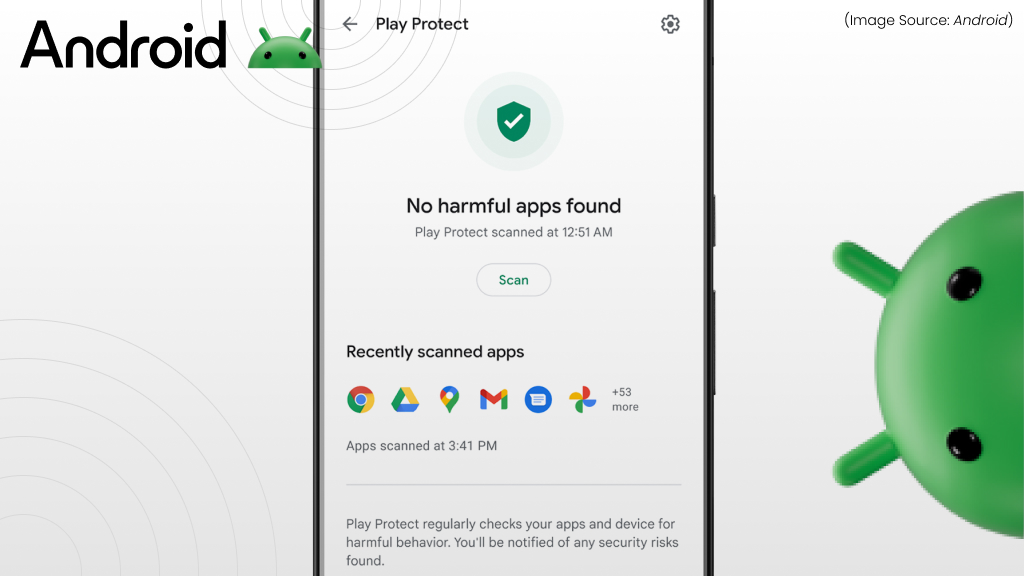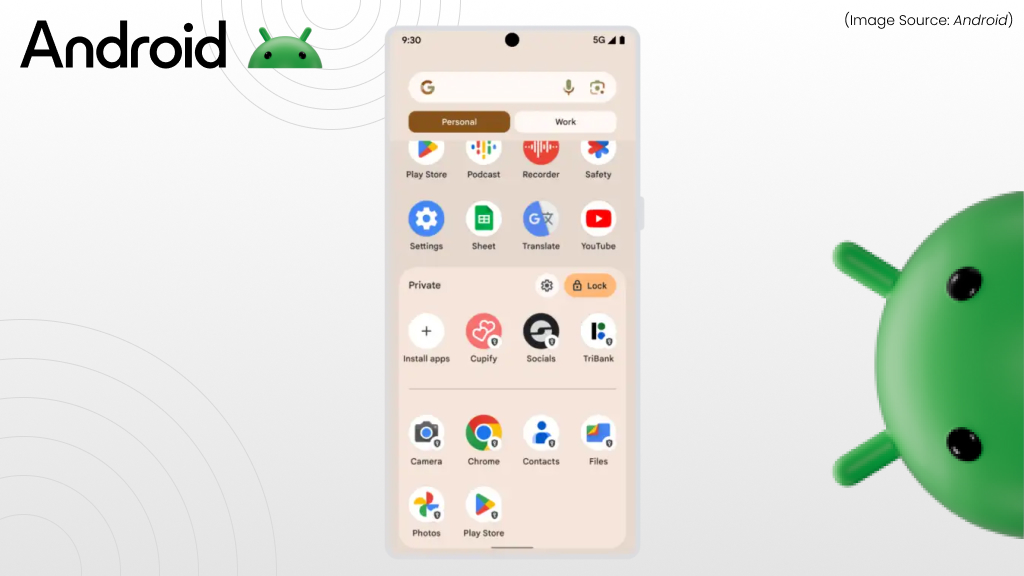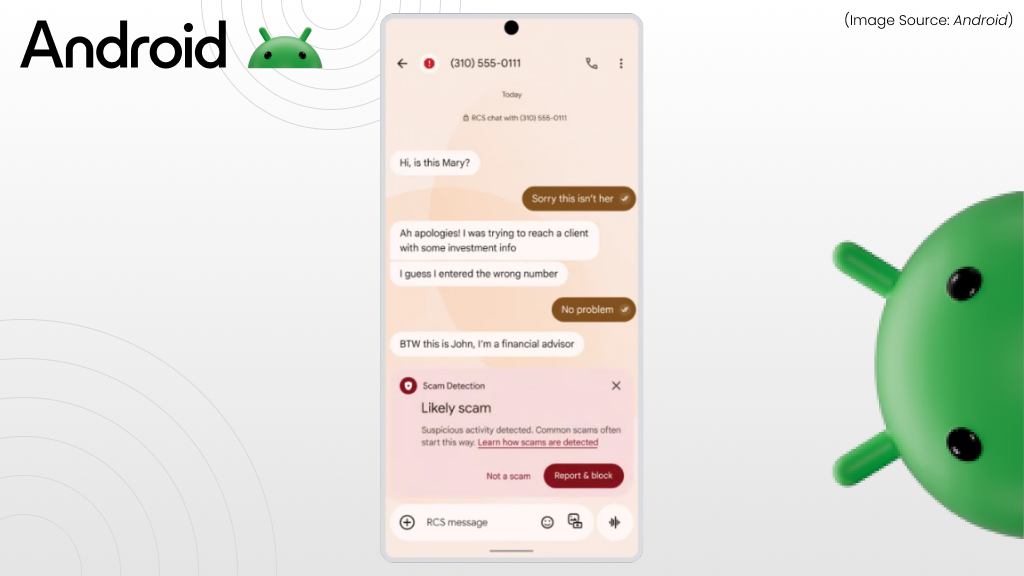
(Image Source: Android)
Android users can expect a safer mobile experience in 2025, thanks to Google’s latest security updates for the Play Store. As digital threats evolve, Google is introducing enhanced safety measures to protect user data, prevent malware, and ensure only trustworthy apps make it to the Play Store.
These improvements include stricter app review policies, real-time threat detection, and more transparent permission handling. Whether you’re a casual user or an app developer, these changes are set to redefine Android security standards.
Why Google Is Strengthening Android Security

(Image Source: Android)
Google is strengthening Android security in 2025 in response to the growing complexity of cyber threats, the rise in malicious app behavior, and increasing global regulatory demands. Over the past few years, attackers have become more sophisticated, often disguising malware as legitimate apps or exploiting permissions to harvest user data. In 2024 alone, multiple high-profile cases of spyware and data leaks highlighted the urgent need for tighter security protocols across Android devices.
Another driving force is user trust. With millions relying on Android for banking, communication, health, and work, ensuring the integrity of the app ecosystem has become a top priority. Google aims to not only block harmful apps more effectively but also provide users with greater transparency and control over their data.
Additionally, compliance with international data privacy laws, such as the EU’s Digital Markets Act (DMA) and India’s Digital Personal Data Protection Act, is prompting Google to adopt more rigorous safeguards. By proactively updating its Play Store policies and improving system-level defenses, Google is working to create a more secure environment for both users and developers. These efforts will help Android maintain its reputation as a reliable and safe mobile platform in 2025 and beyond.
Key Google Play Safety Features Rolling Out to Android in 2025
Based on the latest updates and official announcements, below are the key safety features that are to be released in 2025.
1. Enhanced Google Play Protect with Live Threat Detection

(Image Source: Android)
Google Play Protect with Live Threat Detection is already active, continuously scanning apps to safeguard users from evolving security threats. Now, this feature is being expanded to focus on malicious applications that impersonate financial apps, one of the most deceptive tactics used by cybercriminals.
Fraudulent apps often mimic legitimate banking and payment services, tricking users into entering sensitive credentials or authorizing transactions. With this enhancement, Play Protect will identify suspicious behavior, such as apps falsely claiming to be official financial services. Using on-device analysis through Private Compute Core, these threats are detected in real time without compromising user privacy.
Given that malware is 50 times more common from sideloaded sources than Google Play, this update further reinforces the importance of installing apps from trusted platforms. The expanded detection capabilities ensure users have an additional layer of protection against financial fraud, strengthening the security of Android devices worldwide.
2. Stronger Play Integrity API

(Image Source: Android)
The Stronger Play Integrity API enhances app security by helping developers protect their applications from fraud, tampering, and unauthorized access. This update introduces advanced detection mechanisms that identify abusive devices while maintaining user privacy.
By verifying the authenticity of installed apps, the API prevents compromised or manipulated versions from running. Developers using the Play Integrity API have reported an 80% drop in unauthorized usage, strengthening security across the ecosystem.
This feature ensures that users interact with legitimate applications, creating a safer experience for both developers and consumers. Ultimately, it reinforces trust in the Android platform by mitigating security risks in real time.
3. Sensitive Content Warnings

(Image Source: Android)
Sensitive Content Warnings is a new Google Play safety feature designed to protect users from unexpected exposure to distressing material. Rolling out in 2025, this feature will analyze app content and proactively warn users about potentially graphic, explicit, or triggering material before they engage with it. These warnings help users make informed decisions about whether to proceed with certain apps or media.
By integrating on-device AI and privacy-preserving techniques Google ensures that warnings are accurate while respecting user preferences. This feature reinforces Android’s commitment to user safety and well-being, reducing unintended exposure to harmful digital content.
4. Inactivity Reboot

(Image Source: Android)
The Inactivity Reboot Feature is a new Google Play safety enhancement rolling out to Android in 2025. Designed to improve device security and performance, this feature automatically reboots a device that has been inactive for an extended period. The restart helps clear temporary files, refresh system processes, and ensure security updates are properly applied.
By rebooting inactive devices, Android reduces the risk of unauthorized background activity, including apps running unchecked or exploiting vulnerabilities. This can be especially beneficial for users who forget to restart their phones regularly, as it keeps the system optimized and secure.
Additionally, upon reboot, users will be notified about any security updates that may have been applied. This feature aligns with Android’s commitment to proactive security, ensuring devices remain protected against evolving threats. Whether for personal or enterprise use, this feature strengthens security without requiring manual intervention, offering users peace of mind.
5. Theft Detection and Protection

(Image Source: Android)
The Theft Detection and Protection feature is a major security enhancement coming to Android in 2025, designed to safeguard devices against theft and unauthorized access. Using AI-powered motion detection, Android can identify suspicious behavior, such as rapid movement consistent with a stolen device, and trigger automated security responses.
Once theft is detected, the device can immediately lock itself, preventing unauthorized access to sensitive data. Additionally, location tracking is activated, helping users and authorities locate the stolen phone. This feature works alongside Google Play Protect to ensure security measures remain active even if thieves attempt to disable protections.
Furthermore, stolen devices may restrict certain functionalities, preventing factory resets or unauthorized logins, making them less valuable to thieves. This innovation reinforces Android’s commitment to user safety, offering a proactive defense against mobile theft. With Theft Detection and Protection, users gain an extra layer of security, keeping their personal data and devices protected.
6. Private Space

(Image Source: Android)
The Private Space feature is a new security enhancement coming to Android in 2025, designed to give users a secure, isolated area for sensitive apps and data. This space functions like a separate environment within the device, allowing users to store confidential apps, such as finance, health, or work-related apps, away from the main home screen.
Private Space can be locked separately, requiring authentication for access, ensuring unauthorized users cannot view or open its contents. It also provides additional privacy protections, preventing notifications from appearing outside the secured space.
This feature strengthens Android’s commitment to data security, offering an extra layer of protection for personal and professional information. The ability to seamlessly hide and protect apps reinforces the user’s control over their digital privacy, making Android devices more secure than ever.
7. Scam Detection in Google Messages

(Image Source: Android)
The Scam Detection in Google Messages feature is a new safety enhancement launching in 2025 to help users recognize and avoid fraudulent messages. Using AI-powered analysis, Google Messages will scan incoming texts for signs of scams, including phishing attempts, impersonation, and suspicious links.
When a potentially harmful message is detected, the system will issue a warning, alerting users before they interact with the content. This can prevent financial fraud, identity theft, and deceptive schemes that exploit personal information. Additionally, Google Messages will continuously update its scam detection models based on evolving threats to improve accuracy.
By integrating scam detection on-device, Google ensures user privacy while enhancing security. This proactive approach empowers users to navigate their conversations safely, reducing the risk of falling for deceptive schemes. With growing concerns over digital fraud, Scam Detection in Google Messages reinforces Android’s commitment to protecting users from cyber threats in real time.
These comprehensive safety measures reflect Google’s commitment to enhancing user security and privacy on Android devices in 2025. By integrating advanced technologies and updating policies, Google aims to provide a safer and more trustworthy ecosystem for both users and developers.
What Developers Need to Know About these Safety Guidelines

(Image Source: Android)
With Google introducing significant updates to its Google Play safety guidelines, here’s what developers need to know:
-
Mandatory Organizational Registration for Sensitive Apps
Developers offering financial services, healthcare, VPNs, or government-related applications are now required to register as verified organizationsThis move enhances transparency and accountability, ensuring that critical services are provided by legitimate entities.
-
Revised Photo and Video Permissions
Starting May 2025, apps requesting access to photos and videos must justify their need for such permissions. Developers must submit a declaration or remove unnecessary permissions to comply with the updated policy.
-
AI-Generated Content and Health App Regulations
Google has expanded its policies to address AI-generated content, ensuring it doesn’t mislead users. Health and medical apps must now adhere to updated medical guidance and disclaimer requirements, consolidating health-related policies under a unified framework.
-
Improved Pre-Review hecks
Google Play Console now offers enhanced pre-review checks, allowing developers to identify and resolve policy issues before app submission. This proactive approach helps maintain compliance and reduces the risk of app rejection.
Staying informed and compliant with these updated guidelines is crucial for developers aiming to succeed on the Google Play Store. Regularly reviewing policy changes and utilizing available tools will ensure apps meet the highest standards of safety and quality.














